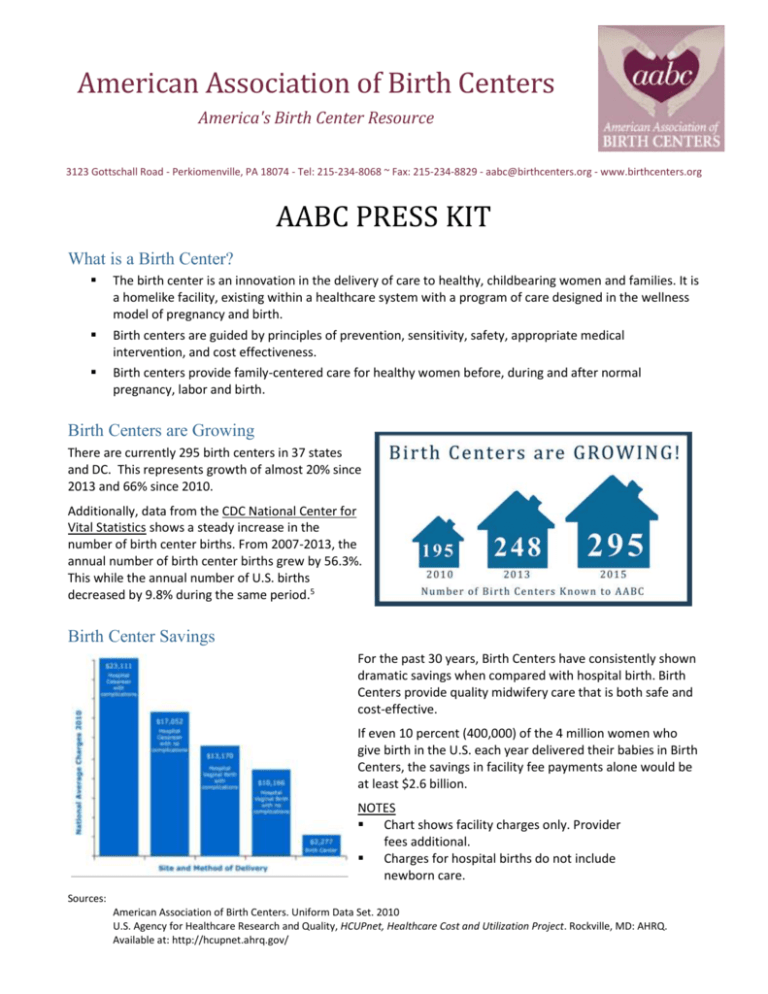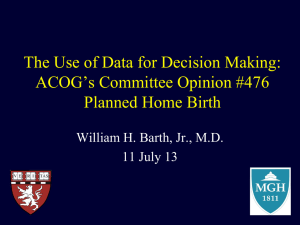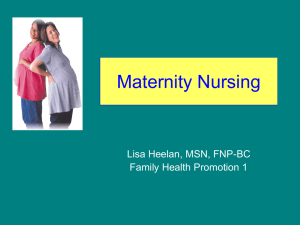our Press Kit here - American Association of Birth Centers
advertisement

American Association of Birth Centers America's Birth Center Resource 3123 Gottschall Road - Perkiomenville, PA 18074 - Tel: 215-234-8068 ~ Fax: 215-234-8829 - aabc@birthcenters.org - www.birthcenters.org AABC PRESS KIT What is a Birth Center? The birth center is an innovation in the delivery of care to healthy, childbearing women and families. It is a homelike facility, existing within a healthcare system with a program of care designed in the wellness model of pregnancy and birth. Birth centers are guided by principles of prevention, sensitivity, safety, appropriate medical intervention, and cost effectiveness. Birth centers provide family-centered care for healthy women before, during and after normal pregnancy, labor and birth. Birth Centers are Growing There are currently 295 birth centers in 37 states and DC. This represents growth of almost 20% since 2013 and 66% since 2010. Additionally, data from the CDC National Center for Vital Statistics shows a steady increase in the number of birth center births. From 2007-2013, the annual number of birth center births grew by 56.3%. This while the annual number of U.S. births decreased by 9.8% during the same period.5 Birth Center Savings For the past 30 years, Birth Centers have consistently shown dramatic savings when compared with hospital birth. Birth Centers provide quality midwifery care that is both safe and cost-effective. If even 10 percent (400,000) of the 4 million women who give birth in the U.S. each year delivered their babies in Birth Centers, the savings in facility fee payments alone would be at least $2.6 billion. NOTES Chart shows facility charges only. Provider fees additional. Charges for hospital births do not include newborn care. Sources: American Association of Birth Centers. Uniform Data Set. 2010 U.S. Agency for Healthcare Research and Quality, HCUPnet, Healthcare Cost and Utilization Project. Rockville, MD: AHRQ. Available at: http://hcupnet.ahrq.gov/ AABC Press Kit 2 What is the birth center experience? The quality of care in birth centers has remained consistent. "The National Birth Center Study," published in 1989, reported the low overall intrapartum and neonatal mortality rate of 1.3/1000 births. The preliminary analysis of data in the AABC Uniform Data Set (2012) shows a comparable intrapartum and neonatal mortality rate of 1.6/1,000. These rates are comparable to studies of low risk, in-hospital births.1, 2 The cesarean section rate for women receiving care in birth centers averages 6.1%, approximately one half that in studies of low risk, in-hospital births.2 Birth Centers have consistently displayed charges for care for normal birth that average up to 50% less than charges for an uncomplicated birth in the hospital. 3, 4 More than half of birth centers include routine laboratory exams, childbirth education, home visits, extra office visits, and initial newborn examinations in their charges. Most major health insurers contract with birth centers for reimbursement. Because charges reflect cost and since the birth center is a single service unit, there is no opportunity for cost shifting or operating the birth center as a “loss leader” to other services. 98.8 percent of women using the birth center would recommend it to friends and/or return to the center for a subsequent birth.1 What are the benefits to families? The birth center approaches pregnancy and birth as a normal family event until proven otherwise. The program encourages family involvement and provides a safe environment for families to experience the social, emotional, and spiritual renewal inherent in birthing forth new life while attending to the possibility that a problem may arise that will require medical intervention or care in the acute care setting of the hospital. This is in opposition to the view that pregnancy is an illness and birth a medical/surgical event that needs to be cured. The birth center program of education encourages parents to become informed and self-reliant; to assume responsibility for their own health and the health of the family. The birth center brings generations together to celebrate new life by encouraging grandparents and children to participate in the birth center program. Birth centers have demonstrated that they are a viable alternative to unattended home birth and to costly hospital acute care for more than 35 years. It is now time to mainstream these services. What are the benefits to business and industry? Birth centers offer business and industry direct savings in the cost of health benefits. If even 10 percent (400,000) of the 4 million women who give birth in the U.S. each year delivered their babies in Birth Centers, the savings in facility fee payments alone would be at least $2.6 billion.3, 4 The birth center program provides a starting base for the wellness and prevention programs being established in industry. The family is the hinge pin of the employee. Industry's support of a program that encourages family unity, self-determination, and responsible health can only improve employee performance. Birth center care encourages childbearing women (who may also be employees) to be confident in the design of their bodies. Such confidence, in turn, builds self-esteem and starts the young family off on thinking of pregnancy, birth, and family health as wellness, not disease. The nine-month intensive focus on improving family health through the promotion of lifestyle changes in pregnancy can have a significant ripple effect in the long-term improvement of family health. AABC Press Kit 3 How will it affect the hospital acute care service? Birth centers have had a major impact on humanizing the acute care maternity services provided by hospitals. Note the rise in hospital birthing rooms, in privileges for nurse-midwives, in childbirth education programs, and in more liberal attitudes about family participation. Birth centers are showing that the majority of women can safely proceed through pregnancy and birth using acute care services only as needed. In wellness orientation to pregnancy and birth, birth centers would be the managed care gatekeepers for the acute care obstetric newborn services. Birth centers eventually will help to reduce the number of costly hospital beds and expand primary care services. Birth centers will help to reduce dependency fostered by institutional confinement and strengthen the family's ability to share responsibility for maternity care and family health. Birth centers will help to develop a system of care based first on the needs of the family and second on the needs of medical education or product promotion. How will it affect the obstetricians? Birth centers provide an opportunity for obstetricians and family physicians to learn, appreciate, and practice midwifery - time and education intensive, "with woman" - care. Birth centers provide an opportunity for obstetricians to invest in a service which will expand their patient base for referrals through transfers from the birth center and from a larger extended family base for their gynecological services. The birth center promotes the development of collaboration and a team approach to the delivery of primary care services to families enabling better use their specialist skills. How is the quality of care assured in birth centers? Through the promotion of state regulations for licensure (41 states currently license birth centers) Through established National Standards which are reviewed annually (adopted in 1985) Through a Continuous Quality Improvement Program for Birth Centers (model program available) Through accreditation by the Commission for the Accreditation of Birth Centers (CABC) How do birth centers contain costs? By retaining autonomy (control) over birth center operations and program regardless of ownership (some hospitals own freestanding birth centers) By providing “high touch” rather than “high tech” care, birth centers depend on the services of acute care hospital thereby minimizing the routine use of medical intervention and technology. By providing a program of primary care that emphasizes education, wellness, prevention, self help and self-reliance in family health maintenance By using staff efficiently; staff are only in-house when a mother is in-house. Since birth centers do not compete with emergency services or hospital acute care, levels of staff are used efficiently and appropriately By promoting responsibility with the childbearing family for health and prevention of illness By using existing community services when available (instead of creating costly duplications) for transport services, social services, medical consultation, laboratories, etc By using established policies and procedures for screening and transfer of women with problems to acute care services By using low cost construction that meets safety codes AABC Press Kit 4 About the American Association of Birth Centers The American Association of Birth Centers (AABC) is a multi-disciplinary membership organization comprised of birth centers, and individuals and organizations that support the birth center concept including certified nurse midwives (CNMs), certified professional midwives (CPMs), physicians, nurses, women and their families. Founded in 1983, AABC is dedicated to developing quality holistic services for childbearing families that promote self-reliance and confidence in birth and parenting. AABC publishes materials on birth centers, sets national standards for birth center operation, and promotes state regulations for licensure and national accreditation by the Commission for the Accreditation of Birth Centers. More information about AABC can be found at www.BirthCenters.org REFERENCES 1. Rooks, J., et al., "Outcomes of Care in Birth Centers: The National Birth Center Study", New England Journal of Medicine, 321:1804-1811, (December 28), 1989 2. Stapleton, S., and Osborne, C. (2011). Birth center outcomes 2010: How to they compare with the national birth center study. AABC Birth Institute. Lecture conducted from American Association of Birth Centers, Denver. 3. U.S. Agency for Healthcare Research and Quality, HCUPnet, Healthcare Cost and Utilization Project. 2010 Data 4. American Association of Birth Centers, AABC Uniform Data Set 2010. 5. U.S. Department of Health and Human Services. Centers for Disease Control and Prevention. National Center for Health Statistics. National Vital Statistics Information. http://www.cdc.gov/nchs/births.htm 1.21.15









